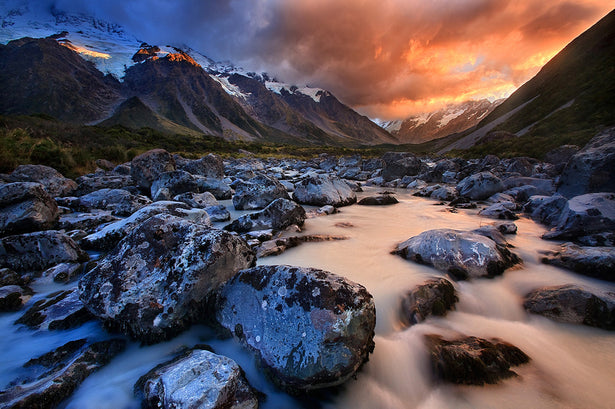Kah Kit Yoong (www.magichourtravelscapes.com) is an Australian-based travel photographer who inadvertently picked up an SLR camera seven years ago. He has been the recipient of numerous prestigious international photography awards such as Veolia / BBC Wildlife Photographer of the Year and Windland Smith Rice contest. His articles and photos have appeared in many publications such as Popular Photography, National Geographic, and BBC Wildlife to name a few. His work has appeared in exhibitions all over the globe, and he is equally in his element whether it be blending into the elegant streets of Paris, standing barefoot in iceberg laden lakes in New Zealand or discussing life in Cuba with a local in his family home.
Kah: "Many people are familiar with the story about how Galen Rowell captured his most famous photo of the rainbow over the Potala Palace. He ran and he ran, ditching equipment as he went till he managed to get the rainbow to line up with the palace. "The Valley of Fire" is one of the photos in my portfolio where I vividly remember desperately pursuing an image on foot.
"I had been based at Mount Cook village in New Zealand for a few days while exploring the southern alps. On the planned date of departure, I awoke to a dreary looking dawn with little promise for any successful photography so I proceeded to pack my gear and set off for the next destination, a fairly long drive away. Later that morning, I noticed a hint of a gap opening up in the heavily overcast sky. I had seen these develop into spectacular light shows numerous times in the past. Since speed was of the essence, I left my camera bag, grabbed my Canon 5D Mark II body with attached zoom lens, tripod, and a few filters and ran like my life depended on it down to the valley. Fortunately, I had done a fair bit of training before the trip, and it didn’t take me too long to cover the three kilometers into the valley where I quickly set up my shot, while my burning lungs recovered. Having scouted out the location previously, I knew exactly where my tripod legs were going to go. As I watched the storm clouds turn into a fireball, I knew the conditions were finally perfect for the composition I had been shooting over the past couple of days. One problem I had been struggling with was that the glacial waters look an unattractive grey under most lighting conditions. What I needed were some strong colours in the sky to reflect off the surface and the mix of intense warm and cool tones were just the ticket.
"Shooting into the direction of the sunrise is always a problem, particularly in mountain scenes where you don’t have the luxury of a ruler straight horizon line to place a hard edged graduated neutral density filter over. Achieving correct exposure in one RAW file proved to be difficult but not impossible. Faced with a challenging dynamic range, one needs to be able to visualize the final result and make some decisions. How much shadow detail will I need to extract? Are there areas of highlights that I can afford to blow out? The answers to questions such as these help determine the exposure. I eventually used a 3-stop soft edged grad down to the bottom of the mountains and a 2-stop hard edge over the sky which controlled the wide dynamic range well. Since I knew that I would want some shadow detail in the mountains and to be able to hold good colour in the highlights, I made as bright an exposure as I could, allowing a few specular fragments where some sun shine was peeping through the clouds to just blow out. According to the histogram, there was enough headroom in the shadows to extract the information I needed in post-processing.
"The post capture workflow was from a single RAW file. Even though my highlights indicator had suggested on my LCD that the highlights were clipped, in reality this was not the case. To draw out all the information from that RAW file as possible, I processed it three times, once for the shadows and then also for midtones and highlights. I blended these by hand to arrive at a file where I had a good tonal range to work with, from the deepest shadows to controlled highlights. I then went through a fairly conventional workflow, tweaking contrast and the like to optimize the image."
KAH'S EQUIPMENT FOR THE SHOT
Camera: Canon 5D Mark II
Lens: Canon 16-35mm f/2.8 L
Settings: ISO 100, f14, 1.3 seconds
Other: Singh-Ray Graduated Neutral Density filters, Gitzo Explorer tripod
Stay connected to Kah: Website | Blog | Facebook
RELATED ARTICLES
Why Shoot With A Prime Lens?
How I Got That Shot: Tony Sweet's HDR Image of New York
Lara Ferroni on Food Photography


